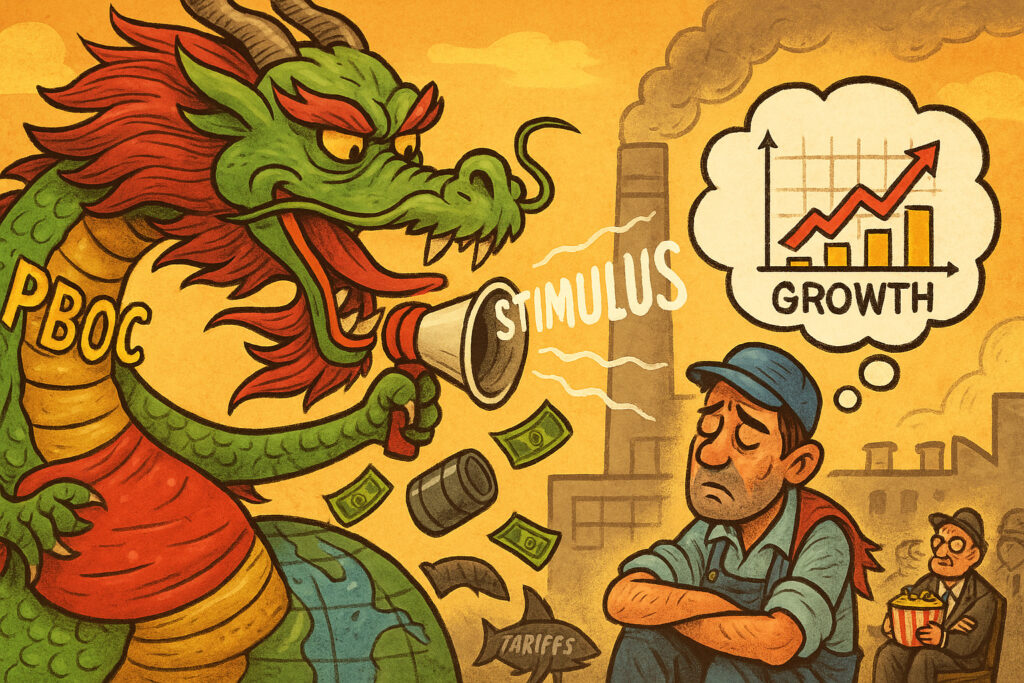Introduction
On June 20, 2025, the People’s Bank of China (PBOC) signaled an accelerated shift toward monetary easing in response to growing evidence of an economic slowdown in the world’s second-largest economy. In an official statement released during its quarterly monetary policy review, the PBOC pledged to “optimize policy tools and speed up implementation” to support domestic demand, stabilize employment, and restore confidence in private investment.
This declaration follows a series of underwhelming economic prints, including weaker-than-expected industrial production, declining exports, and a softening property market. Financial markets responded swiftly to the PBOC’s tone, with Chinese equities rallying, bond yields falling, and the yuan briefly weakening before recovering on state bank support.
This article examines the PBOC’s policy shift in detail, analyzes cross-asset market reactions, and evaluates implications for global markets, especially amid diverging central bank trajectories worldwide.
Macroeconomic Backdrop: Recovery Falters
China’s economic data for May pointed to a fragile post-pandemic recovery losing steam:
- Industrial Production: +3.1% YoY (vs. 3.8% expected)
- Retail Sales: +2.9% YoY (vs. 3.6% expected)
- Fixed Asset Investment: +4.0% YTD (down from 4.5%)
- Property Investment: -9.2% YTD
- Youth Unemployment: 18.7%
With weak consumer sentiment and falling real estate investment, policymakers are under pressure to act decisively to sustain GDP growth, now projected at 4.6% for 2025—below Beijing’s 5% target.
PBOC Policy Statement: Easing Bias Intensifies
The June policy review emphasized three key strategies:
- Monetary Easing:
- Further cuts to the Loan Prime Rate (LPR) expected in Q3.
- Potential reduction in Reserve Requirement Ratio (RRR) by 50 bps.
- Liquidity Support:
- Boost in targeted Medium-Term Lending Facility (MLF) operations.
- Liquidity injections to smaller banks to support SME credit.
- FX and Stability Tools:
- Tighter supervision of cross-border capital flows.
- Coordination with state banks to manage currency volatility.
PBOC Governor Pan Gongsheng stated, “We must act with greater intensity and precision to protect our recovery and ensure financial stability.”
Market Reaction: Equities Rally, Yields Decline
Chinese equity markets responded positively to the easing tone:
- Shanghai Composite: +1.7% to 3,256.90
- CSI 300: +2.1% to 4,015.12
- Hang Seng Index: +2.4% to 19,040.55
Financials, real estate, and consumer discretionary sectors led gains, reflecting expectations of improved credit conditions and renewed policy support for domestic consumption.
Onshore bond yields fell:
- 10-year Chinese government bond: Down 5 bps to 2.58%
- 5-year yield: Down 6 bps to 2.42%
Bond futures saw strong buying interest, particularly among insurance and asset management firms.
Currency Markets: Yuan Volatility Managed
The yuan initially weakened past 7.30 per dollar, touching 7.32 intraday before rebounding to 7.27 after state-owned banks reportedly sold dollars to stabilize the currency.
The PBOC fixed the USD/CNY midpoint at 7.2150, stronger than market expectations, signaling its intention to limit disorderly depreciation. The CFETS RMB Index slipped to 96.4, a two-month low.
Global FX traders now expect wider daily volatility bands but continued policy intervention to avoid capital flight and imported inflation.
Commodities and Global Spillovers
Commodity markets responded with cautious optimism:
- Copper: +1.6% to $9,920/ton, on demand expectations
- Iron Ore: +2.3% to $122/ton (Dalian futures)
- Oil: Flat at $91.60/barrel, little impact from China news
A rebound in Chinese demand is critical for metals and bulk commodities, particularly for exporters in Australia, Brazil, and Southeast Asia. However, persistent property weakness tempers long-term demand outlooks.
Impact on Emerging Markets and Global Assets
EM equities and bonds rallied in sympathy:
- MSCI EM Index: +0.8%
- iShares JP Morgan EM Bond ETF: +0.5%
Currencies of major China trade partners appreciated:
- Australian Dollar: +0.6% to 0.6720 USD
- Brazilian Real: +0.4% to 4.89/USD
Global risk assets welcomed signs of Chinese stimulus, especially amid recent geopolitical volatility. However, investors remain cautious about the scale and sustainability of Beijing’s efforts.
Policy Divergence Widens Globally
China’s dovish pivot contrasts with the Fed’s steady stance and the ECB’s gradual easing path. The divergence may encourage capital flows into U.S. and European assets unless China accelerates credit transmission to the real economy.
Global investors are watching how PBOC tools affect consumer behavior and private investment, both of which have lagged in the recovery.
Analyst and Investor Reactions
Strategists welcomed the shift but called for tangible follow-through:
- Morgan Stanley: “PBOC rhetoric is turning, but real stimulus must be credit-positive and visible on the ground.”
- HSBC: “Look for coordinated fiscal-monetary packages in H2.”
Private equity and hedge funds active in Asia are reportedly reviewing exposure to Chinese consumer plays and property-linked fixed income.
Conclusion
The PBOC’s June 20 policy message marks a definitive shift toward faster and broader monetary easing as economic momentum stalls. Financial markets welcomed the dovish tilt, with equities and bonds rallying and the yuan stabilizing after state support.
Key questions remain:
- Will rate cuts and liquidity injections be sufficient to lift domestic demand?
- Can the PBOC contain yuan volatility without further draining reserves?
- How will global markets adjust to China’s stimulus amid diverging central bank policies?
With risks rising and growth slipping below target, the PBOC appears ready to act with greater urgency. Yet the credibility and scale of stimulus measures will ultimately determine their effectiveness in reviving confidence and stabilizing China’s economy.
June 20 may be remembered as the inflection point in China’s 2025 policy cycle. For investors globally, it signals a potentially pivotal shift in emerging market dynamics and commodity demand expectations as the world’s second-largest economy seeks to recalibrate its trajectory.
